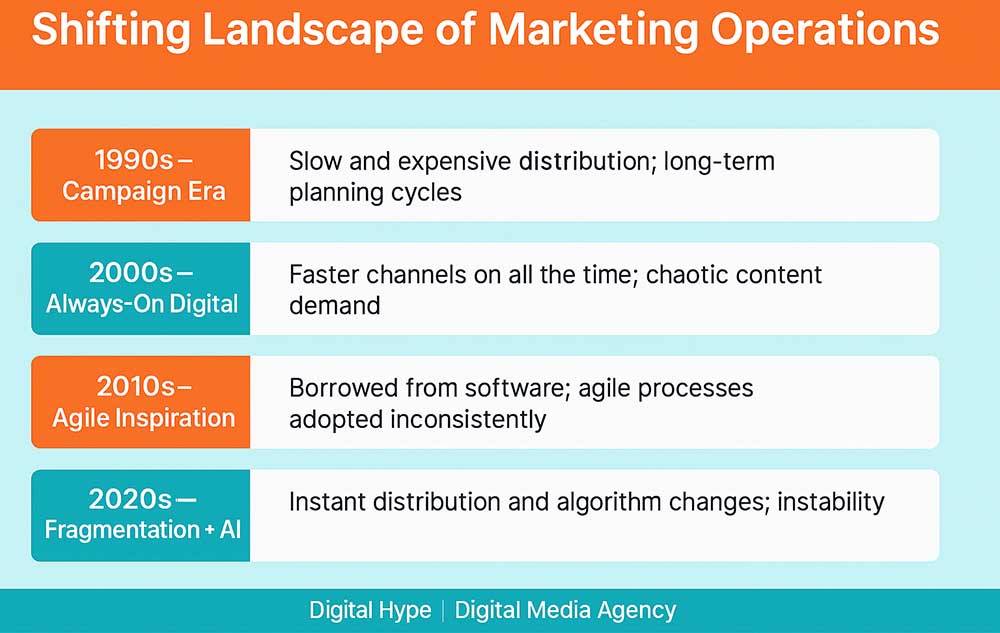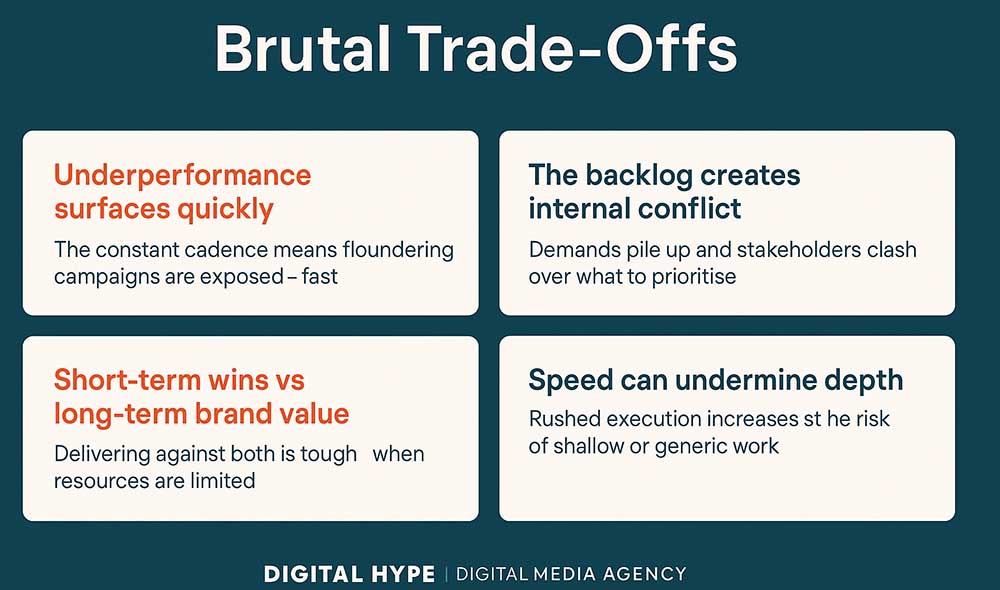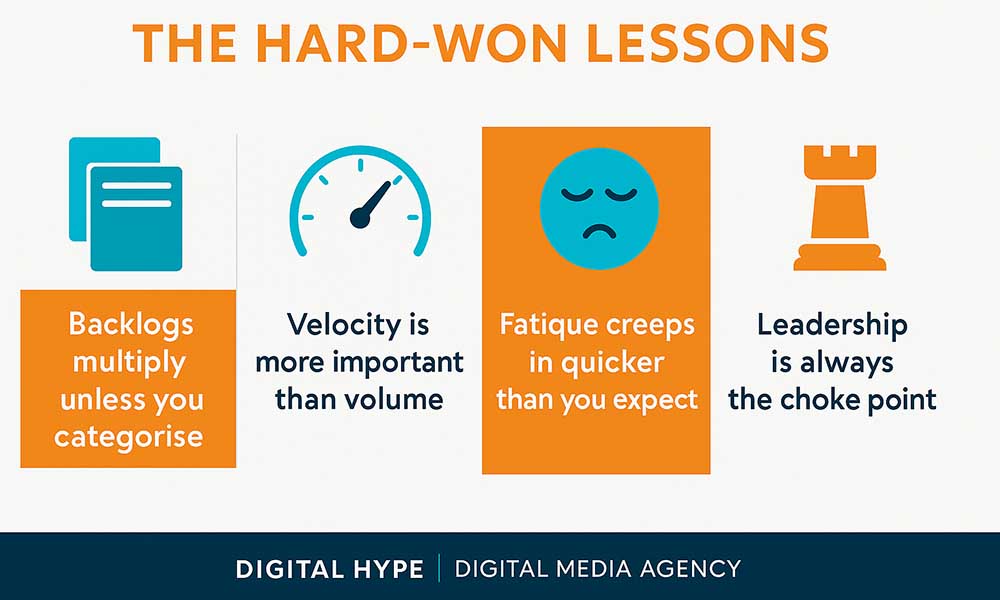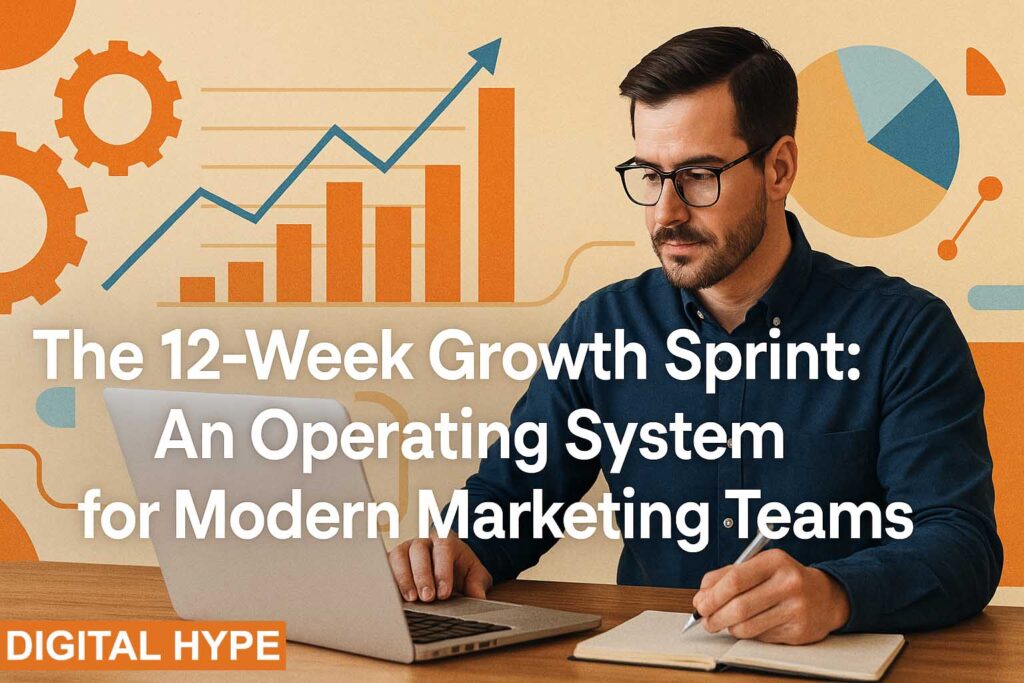First Things First: What Exactly Is a Growth Sprint?
A Growth Marketing Sprint is a 12-week rhythm that forces marketing teams to stop scattering their energy and instead work in focused, test-and-learn cycles.
Why 12 weeks? Because it’s long enough to get meaningful results (especially for SEO or web changes) but short enough to keep urgency alive. I’ve seen too many teams in Bournemouth and beyond spend nine months “planning” only to ship something the market no longer cares about.
That’s the core of the ‘Growth Sprint’: speed plus accountability without losing sight of the bigger picture.
Why Businesses Can’t Afford Business-as-Usual
Most marketing today is a mess of half-finished ideas and vanity reporting. You’ve probably felt it yourself, a boardroom meeting where someone presents “engagement stats” from LinkedIn, another mentions a Google Ads click-through rate, and someone else points out last month’s bounce rate. It’s noise, not clarity.
The Growth Sprint forces businesses to cut through the noise. For an SME, that might mean saying: “Right, for the next 12 weeks our only focus is creating one high-performing content cluster and fixing our broken contact form. Everything else waits.” For corporates, it creates a structure that finally makes teams accountable to each other, not just their silo.
Without a system like this, marketing becomes a treadmill, lots of sweat, little movement forward.
How We Got Here: The Shifting Landscape of Marketing Operations

To understand why Growth Sprints work, you need to know how marketing planning has evolved:
- 1990s – Campaign Era: Brands ran seasonal campaigns, often tied to TV or print schedules. Planning cycles could last six months because distribution was expensive and fixed.
- 2000s – Always-On Digital: Google Ads and early social meant campaigns never switched off. Suddenly every day became “campaign season.” Marketers had to keep the lights on 24/7.
- 2010s – Agile Inspiration: Software teams were delivering updates weekly. Marketers borrowed agile language, but often without true structural change. Stand-ups happened, but output didn’t shift.
- 2020s – Fragmentation + AI: Today, every channel has its own cadence and algorithm shifts overnight. Add AI-driven search, and the old quarterly or annual plan is dead. The only survival mechanism is a rhythm that adapts constantly, hence the rise of sprint operating models.
The big lesson? Marketing planning cycles have always followed the cost and speed of distribution. Now distribution is instant, so planning must be too.
The Brutal Trade-Offs Nobody Tells You

Most blog posts about Growth Sprints will sell you the upside, faster results, more accountability, clearer priorities. All true. But here’s what rarely makes it into the marketing:
- Underperformance surfaces quickly.
A sprint exposes whether work is actually delivering. If your SEO partner promised a ranking lift in 12 weeks and the needle hasn’t moved, the sprint cycle makes that crystal clear. There’s no hiding behind annual reviews. That’s uncomfortable, but it forces better decisions. - The backlog creates internal conflict.
When all priorities sit in one place, different teams fight for airtime. Sales want quick lead-gen, brand pushes for equity, and product sneaks in launches. I’ve watched this play out in SMEs and corporates alike. The backlog doesn’t create politics, but it makes them visible, which, handled well, is healthier than the silent tug-of-war most businesses live with. - Short-term wins can compromise long-term brand value.
Sprint cycles reward quick validation, but not everything worth doing fits a 12-week window. I’ve seen businesses chase traffic hacks that worked briefly but led to SEO penalties months later. Guardrails are essential, ringfence capacity for long-horizon projects that protect brand equity. - Speed can undermine depth.
Momentum is valuable, but it comes with risk. Teams eager to “ship something” sometimes release assets that aren’t ready, creating rework later. Data from agile software teams shows that rushed releases often double total workload because fixes eat into future sprints. Marketing is no different.
The point isn’t that Growth Sprints are flawed. It’s that they’re honest. They show you where your processes, people, and priorities are out of sync, quickly. For leaders ready to face those truths, sprints become transformative. For those looking for an easy fix, they can feel brutal.
Case Story: A Dorset Firm That Stopped Spinning Plates
One client, a professional services firm in Poole, lived in “marketing chaos.” They jumped from LinkedIn posts to random email blasts, then threw money at paid ads when panic set in.
When we introduced Growth Sprints, the first battle was cultural. The MD couldn’t understand why we’d freeze 80% of ideas for 12 weeks. “What if we miss something?” he asked. My answer: “You’re already missing everything.”
Within that first sprint:
- SEO research unearthed entity gaps on their site.
- A broken form on mobile was fixed — instantly lifting conversions.
- A social test campaign identified the one post format that actually drove consultations.
By week 10, their pipeline looked healthier than the last six months combined. Not because of magic tricks, but because they stopped chasing distractions.
Growth Sprint vs Traditional Campaign Planning
Think of it like this: traditional marketing campaigns are like moving house, you plan for months, spend a fortune, then collapse. Growth Sprints are like weekly shopping, lighter, repeatable, and designed to keep the household running.
| Traditional Campaigns | 12-Week Growth Sprints | |
| Planning Horizon | 6–12 months | 12 weeks |
| Flexibility | Minimal | High |
| Ownership | Diffused | Clear backlog owners |
| Metrics | Often vanity | Pipeline-driven |
| Risk | Misses market shifts | Higher, but faster correction |
The difference is momentum: campaigns pause, sprints compound.
Insider Knowledge: The Hard-Won Lessons

This is the part you don’t usually get in playbooks or LinkedIn carousels. These are the lessons you only learn after running multiple Growth Sprints, and getting some of them wrong.
1. Backlogs multiply unless you categorise.
The first time I ran a sprint for a Bournemouth SME, we lumped everything into one giant backlog: SEO fixes, social media campaigns, web dev, brand projects. The urgent items bulldozed everything else. Only after we separated demand-gen, content, UX, and technical streams did the strategic work start to get airtime. Without categories, the backlog becomes a dumping ground.
2. Velocity is more important than volume.
Beginners obsess over outputs, “we published five blogs this sprint.” Pros track velocity of outcomes, “two blogs generated qualified leads.” In agile software, velocity is a measure of throughput. In marketing, I’ve found it works best when tied to validated learning: how many tests did we run, and how many moved the needle?
3. Fatigue creeps in quicker than you expect.
Teams love the buzz of the first sprint. By the third cycle, cracks show, meetings feel heavier, energy dips. At one corporate client, designers burned out after four back-to-back sprints because leadership insisted “keep the rhythm.” We now recommend deliberate “reset weeks” every 2–3 cycles. Pausing is part of sustainability.
4. Leadership is always the choke point.
This one stings, but it’s true. Every failed sprint I’ve seen came down to senior interference. A director swoops in mid-cycle and reprioritises, blowing up the backlog. In SMEs, it’s usually the MD. In corporates, it’s a steering committee. Unless leadership agrees to protect the cadence, the system unravels.
These aren’t flaws in Growth Sprints, they’re reality checks. When you know where the traps lie, you can plan for them. And when you do, the system becomes incredibly powerful.
Want to Run Growth Sprints Without the Stress?
Our Online Marketing team helps UK businesses build 12-week sprint systems that align SEO, web, and social into a single growth engine.
Book a ConsultationService-by-Budget: What Fits Where
Independent Businesses (£1k–£2k per month)
Keep it lean. One backlog, one channel focus, simple rituals. Don’t over-engineer.
SMEs (£3k–£7k per month)
The sweet spot. Multiple channel sprints, backlog prioritisation, real measurement discipline.
Corporates (£10k+ per month)
This is orchestration. Several sprint teams, governance layers, exec scorecards, quarterly resets. Done badly, it becomes bureaucracy. Done well, it drives alignment across departments.
Your Growth Sprint Questions Answered
Why 12 weeks and not 6 or 24?
Twelve weeks strikes the balance. Six weeks is too short to see impact in areas like SEO or web fixes. Twenty-four weeks loses urgency. Three months is enough to deliver outcomes and still feel intense.
Do I need a big team to run Growth Sprints?
No. I’ve seen one-person businesses in Bournemouth run personal sprints using a Trello board and fortnightly reviews. SMEs benefit most (3–12 person marketing teams), while corporates need multiple sprint squads with governance. The model scales.
What results should I realistically expect after one cycle?
Not overnight miracles. Typically, you’ll see early directional wins: cleaner UX, early SEO ranking movement, or tested social formats. By the second or third cycle, the compounding effect shows in pipeline and revenue.
Isn’t this just “Agile marketing” rebranded?
Agile is a philosophy; sprints are an operating system. Agile tells you how to think. Growth Sprints give you the rules of play — backlog, cadence, rituals, velocity metrics.
How do I know what to prioritise in the backlog?
Use scoring models like ICE (Impact, Confidence, Effort). For independents, it might be “which task gets me leads fastest.” For corporates, it might be “what aligns with Q3 revenue targets.” The principle’s the same, but weighting shifts.
What tools do I actually need to start?
At minimum: a shared task board (Trello, Asana), analytics (GA4), and somewhere to record learnings. SMEs often add Slack or Teams for comms. Corporates invest in Jira, Confluence, or enterprise data layers. Start lean; sophistication can grow.
What happens if leadership keeps interfering mid-sprint?
This is the most common failure pattern. You need a governance agreement: once a sprint starts, backlog is locked. If leadership won’t respect that, sprints collapse. In corporates, steering committees often need retraining on this.
How do Growth Sprints fit with long-term brand building?
They don’t replace long-term strategy — they operationalise it. The trick is to ringfence 20% of sprint capacity for projects that don’t show ROI in 12 weeks but protect brand equity (like cornerstone content or accessibility upgrades).
Can agencies work inside Growth Sprints?
Yes, but they have to adopt your rhythm. If your social agency works ad hoc while you’re sprinting fortnightly, friction will kill momentum. The best agencies integrate — attending backlog reviews, showing deliverables at sprint demos.
How do corporates avoid turning sprints into bureaucracy?
The danger is too many meetings. Successful corporates keep squads autonomous but roll up into a shared scorecard for the exec level. Governance should protect cadence, not choke it.
What’s the cost difference between doing this lean vs at scale?
An independent can run a sprint with £0 tools and time discipline. SMEs often budget £3–7k monthly to cover execution plus facilitation. Corporates invest £10k+ to coordinate multiple sprint teams. The method flexes with resources.
What if my team burns out after back-to-back sprints?
Plan recovery cycles. After two or three 12-week blocks, schedule a reset week. Without it, sprint intensity turns into fatigue, and output quality drops. This is as true for SMEs as for enterprise-level teams.
How do I explain this to a sceptical board or MD?
Frame it as risk management. Traditional annual planning risks wasting six months before realising something isn’t working. Growth Sprints reduce the cost of failure by surfacing problems earlier. Boards tend to listen when framed in financial risk, not “marketing language.”
Why You Can’t Ignore This
Here’s my blunt view: if your marketing still runs on old campaign cycles, you’re at risk. By the time your 12-month plan is half delivered, AI-driven search has changed, algorithms have shifted, and customer attention has gone elsewhere.
Growth Sprints are not a shiny framework. They’re survival. For independents, SMEs, and corporates, it’s the difference between controlled iteration and expensive chaos.
Ready to Transform How Your Marketing Operates?
Stop wasting energy on scattered campaigns. Our Digital Marketing team works with independents, SMEs, and corporates across Bournemouth, Dorset, and the UK-wide to build sprint-driven systems that deliver measurable growth.
Start Your First Sprint

